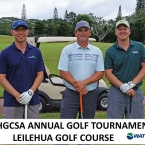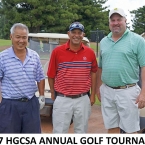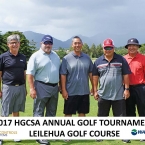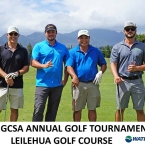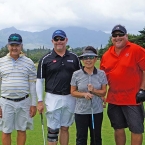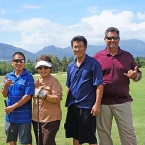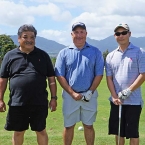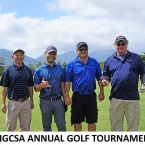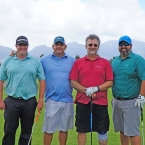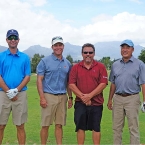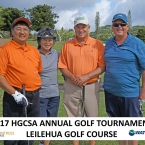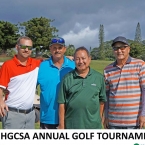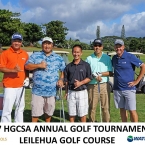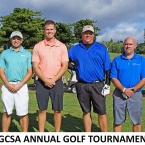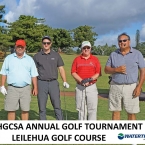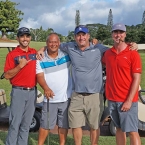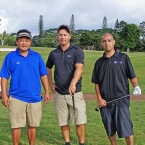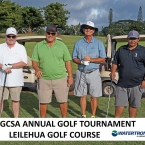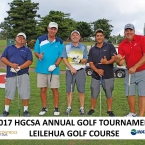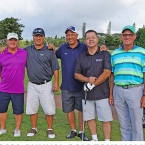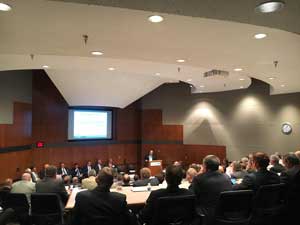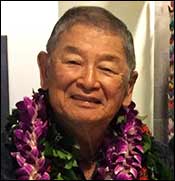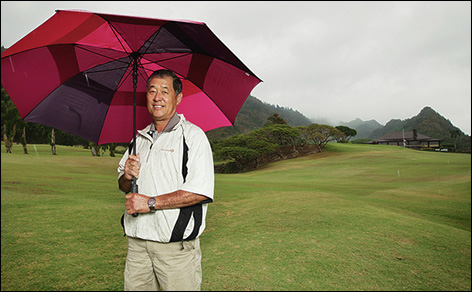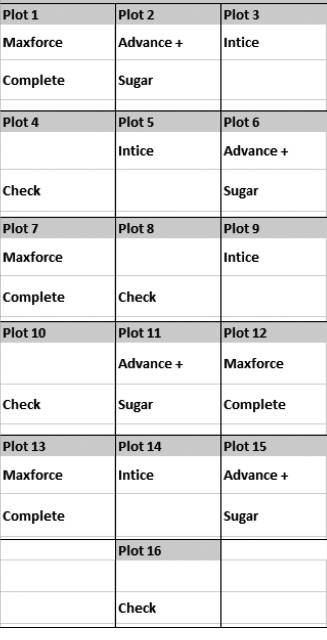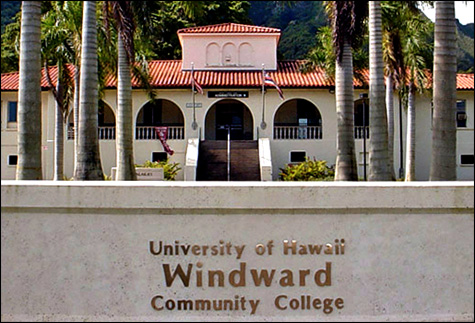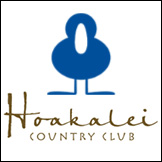Hawaii Golf Course Superintendents Blog
Individual Pairings/Group Photos from the HGCSA 2017 Annual Golf Tournament
This years Tournament was a spectacular success giving Association members the opportunity to network and communicate with their community and with other professionals in the Hawaii Golf Industry — and it was just GOOD FUN!
Much of the credit for this very enjoyable event goes to our Sponsors. Please Visit the HGCSA Golf Tournament Sponsors page by Clicking Here.
To Visit the main Tournament photo gallery page please Click Here.
Delegates Post Meeting Report and the Official “Communication” from the GCSAA

Most of day was talking about changing the By-Laws, the By-Laws were sent to an Law firm that recommended a number of wording changes. The one that was discussed the most was about voting at the GIS, having the candidates that are running for the BOD be voted in for each position separately instead of the two top vote getter. Then if a appointment for a 1 year term is needed there will be a vote for that position instead of the President appointing someone. The other changes were about membership classifications.
The Code of Ethics were revised and all items that were not legally enforceable were struck.
National Golf Day this past spring was a success and the project on the Mall was a lot of fun for everyone. Next year the group would like to do a bigger project. Meeting the Congress members of course was the main reason for Golf Day.
GCSAA is setting up a political action committee or PAC in order to gain access to members of Congress that can help the game of golf.
A certificate program for Turf Equipment Managers and Assistant Superintendents is being worked on.
Any questions please let me know.
Russell Dooge, CGCS
One last thing, please let me know who you would like to be Superintendent of the Year and the reason why. Thank you Russ
Complete Delegates Post Meeting Communication from the GCSAA
Father and son honored by Hawaii Golf Course Superintendents Association

CLICK to view article on http://www.staradvertiser.com
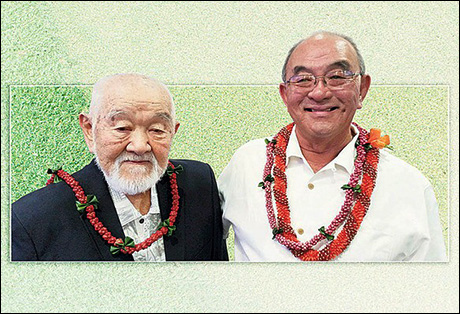
Photo Courtesty Honma Family
Hawaii Golf Course Superintendents Association members vote for their superintendent of the year. The HGCSA board chooses its lifetime achievement award winner.
Kama‘aina who have golfed at Turtle Bay and Kapalua, and folks who have watched tour events on those courses in the midst of breathtaking views, probably aren’t surprised at the most recent selections.
Short Honma, who gave up farming and ultimately helped open all three Kapalua Resort courses, was honored with the lifetime award.
The 91-year-old followed his son into the golf business. Michael Honma, who has hosted 16 tour events at Turtle Bay since he started there in 1982, is superintendent of the year.
Both have seen Hawaii golf mature and modernize dramatically in their careers and played a primary role. Not bad for a bunch of farmers.
2016 GCSAA Delegates Meeting Report
A few weeks ago I attended the 2016 GCSAA Delegates Meeting in Kansas as your representative and this an summary of that meeting.
. . . Russ
Eighty-two delegates from 84 chapters convene at GCSAA headquarters
Membership engagement and growth, advocacy efforts and an upcoming best management practices guide were among the key topics of the 2016 Chapter Delegates Meeting. The 82 delegates from 84 chapters also heard from nominees for the 2017 GCSAA Board of Directors. The two-day meeting, held Oct. 11-12 in Kansas City, Mo., and at GCSAA headquarters in Lawrence, Kan., also offered delegates the chance to discuss issues and provide input in small group sessions and during a “town hall” session.
Key Messages
- CPI Dues Process– GCSAA has a long-term membership dues pricing structure that ties a proposed dues increase to the Consumer Price Index (CPI) . The GCSAA Board makes a recommendation to the membership on changes to A, B or C membership dues every two years based on the CPl. The CPI increased by 1.2% over the past two years and this translates to a proposed of $5 dues increase for A, B and c members. This proposed increase will be voted on at the Annual Meeting. The delegates also heard about a proposed Bylaws amendment in which the dues approved by the membership could not exceed the set amount. This would allow flexibility to offer introductory, reduced membership dues for new members or other entities.
- Political Action Committee – GCSAA is investigating the possibility of resurrecting a GCSAA Political Action Committee (PAC) to further its advocacy efforts on behalf of the membership and remain the leader in advocacy for the golf industry. GCSAA stressed that if a PAC were started the money distributed would be to aid champions of policies that advance GCSAA ‘s priorities from the GCSAA Priority Issue Agenda, not a particular person or party. Staff will provide additional educational materials to each chapter before year end to help gauge the level of interest . Please contact Chava McKeel if you have questions about a PAC at 800-472-7878 or [email protected]. Your comments will be vital to shape the direction of this initiative.
- Rounds 4 Research Auction -The delegates celebrated the success of the top 4 chapter fundraisers in the 2016 R4R Auction. Chapters are encouraged to find a champion – a delegate, the president, chapter executive- someone who will spearhead the initiative in their chapter. 2017 Auction will be April 1-9. Chapters just need to recruit the rounds to donate – GCSAA administers the rest of the program. Call or email Mischia Wright, Associate Director, EIFG at 800-472-7878 or [email protected].
- Member Engagement Through Committees and Task Groups – Delegates learned more about GCSAA’s committee and task group process. We are asking you to spread the word that GCSAA is looking for volunteers. The Call for Volunteers for 2017 will open on November 1. More information will be available on the GCSAA website or call our office at 800-472-7878.
- Membership Growth – GCSAA has a renewed focus on membership growth and value. We need your help at the local level as we are working to achieve a set goal of 20,000 members by 2020. Delegates were presented with several different membership growth initiatives , including ideas to partner with affiliated chapters. Delegates heard about, and asked questions concerning, potential bylaws definition changes surrounding the ISM and EM classifications aimed at being more inclusive and introducing others to golf employment opportunities.
- Department of Labor Overtime Rule – December 1, 2016 is the deadline when the new Department of Labor overtime pay rule goes into effect. The final rule will raise the exempt salary threshold indicating eligibility from $455/week to $913 ($47,476 per year). All golf facilities should come into compliance with this significant jump in the salary threshold in the next 6 months. GCSAA has provided a webinar and other important resources to help you get ready for the change at http://www.cgrcengage.com/gcsaa/Labor.
- BMP Planning Guide and Template– Delegates heard about GCSAA’s 50 by 2020 BMP initiative. This aims to have all 50 states with a golf centric BMP program in place by 2020. GCSAA unveiled portions of its new BMP Planning Guide and online template which can be utilized by the chapters creating the state level BMPs programs. We will need your help at the local level as key constituents within your state and chapter will play a vital role in this initiative.
- Interactive Meeting– Delegates took part in small group discussions and an interactive Town Hall with the GCSAA Board of Directors.
- Candidate Presentations and Breakouts– the candidates for the 2017 GCSAA Board of Directors gave presentations and hosted breakout rooms for the delegates. The delegates were awarded ample time to interact and ask questions of the candidates . Those running for the 2017 GCSAA Board of Directors are:
- For President- Bill H. Maynard, CGCS
- For Vice President- Darren J. Davis, CGCS
- For Secretary/Treasurer
- Rafael Barajas, CGCS
- John R. Fulling, Jr., CGCS
- For Director (Six members are on the slate for three director positions)
- Mark F. Jordan, CGCS
- Jeffrey F. Millies, CGCS
- Kevin P. Sundermao
- Rory Van Poucke
- John Walker
- Jeff L. White, CGCS
Nakatsukasa’s keeping it green
As Clarence Nakatsukasa approaches his 80th birthday, he is closing his latest career, presumably so he can play more golf.
Fittingly, the Hawaii Golf Course Superintendents Association awarded its executive director a Lifetime Achievement Award at February’s annual golf Ho‘olaulea. Nakatsukasa will retire as ED the end of this year.
He will retire again. The award was given for his service to Hawaii golf, his country and community. There have been several retirements.
Nakatsukasa graduated from the University of Hawaii in 1959 with a degree in history. Then he set about making some.
His Army career covered the next 20 years and he retired — for the first time — as a major. Military awards included the Legion of Merit, Bronze Star, Meritorious and Commendation Medal and Vietnam Campaign and Service Medal.
His golf game also was impressive.
“Golf gave me a lot of opportunities,” Nakatsukasa recalled about his military days. “I met a lot of people, played courses all over the world — on the mainland, in the Far East and Hawaii. The game really helped me in my career so I’m trying to give back. That’s why I’m still doing it.”
When he came home, Nakatsukasa was a Personnel Management Specialist with the Army Corps of Engineers and at Pearl Harbor Naval Base, along with Administrator for COMSAT, a satellite communications company.
His golf career — basically his third career — wouldn’t start until 1988, when his kids were out of school. He was a starter at Ala Wai and Golf Operations Assistant at Ted Makalena, then at Pali.
In 1994, the history major accepted the position of Golf Course Superintendent at Ala Wai, one of the busiest courses on the face of the earth. A year later, he began serving on the HGCSA board of directors.
Nakatsukasa’s training for his new position consisted of a huge course load ahead of time and hours of reading course maintenance material. He talked early and often with his new peers, along with suppliers of everything from equipment to fertilizer.
“I learned a lot from them,” he recalls, “and experienced a lot on my own.”
There was a lot to experience, with his assistant by his side. They usually showed up at Ala Wai at 4:30 a.m. and finished between 2-3 p.m. Nakatsukasa, who worked Pali simultaneously for eight “overwhelming” months, would be back on the weekend to play, and keep an eye on the place.
Along with the crowds, the flat course also has to deal with an abundance of salt in the soil, which causes bare spots. Its greens, which can be surprisingly good for a municipal course, are immensely difficult to maintain and nurture.
Along with everything else — for a multitude of reasons some courses face, and many do not.
“We’d be trying to do things to the golf course, but we’ve got so many people on it that it’s really hard to work around them,” Nakatsukasa recalled. “We had a lot of unhappy people when we’d close certain sections of the golf course. I always tried to talk to them and said, ‘Look, we’re trying to make it better for you guys,’ so they kind of understood.”
Ala Wai, with its legendary six-somes, not only deals with massive numbers on the course. It has relatively few maintenance workers, particularly in comparison to resort and private courses.
“The difficulty was not having the resources,” Nakatsukasa says. “Meaning primarily people and money and equipment. We have to make do with what’s available. We had to work hard and you had to get your workers convinced about what the job was all about, and why it was important to do the best you could.”
He sometimes still speaks about Ala Wai in the present, but he retired — again — 10 years ago. He quietly became the HGCSA’s first Executive Director. “For me,” he admits, “it’s a volunteer position.”
Golf must be a passion. He has worked too hard for it to be anything else.
“Maybe I’m crazy,” Nakatsukasa says. “I always felt along the way that golf was really good to me so I’m always trying to give back to something that did a lot for me.
“When I was playing and in the military I was a pretty decent golfer. A lot of people, I’m talking about generals and officers and members of Congress, I’ve gone out and played with them because I was involved in the game. That helped me in my career. Once I was done with that I needed to give back so that’s what I want to do now.”
Sounds like yet another career might take him into his 80s.
Curtis Kono Featured in Star Advertiser Article
It’s a walk in the park for golf groundskeeper Kono

Curtis Kono has an intriguing way of describing the rarefied air at The Masters. It is colored by his life as a horticulture major, Manoa Cup champion, keeper of the greens at one of Hawaii’s most venerable golf courses and pineapple carver extraordinaire.
By Ann Miller Special to the Star-Advertiser
Kono calls Augusta National “a walk in the park.” Or, in his case, a ride on the mower as the sun comes up and goes down every April. He will serve as a volunteer greenskeeper for the 17th time at next week’s Masters.
Kono says the same about all the classic courses he has visited. The elite list includes a British Open at Royal Birkdale and U.S. Open at Shinnecock. He worked both as a volunteer with the grounds staff and will add Hazeltine later this year when he helps prepare it for the Ryder Cup.
He will be one of 30 “out of state/foreign” volunteers in Minnesota. He is one of 75 at Augusta, getting called in the first time he inquired in 2000, with his impeccable resume helping him leap over a waitlist that is reportedly thousands long.
“I’ve always enjoyed experiencing different venues and playing top-ranked courses all over our country and the world,” Kono explains. “I’ve been very fortunate that this game of golf has allowed me to meet a lot of good people and visit a lot of beautiful places over the five decades I’ve been connected with it. How gorgeous many of these places are … a walk in the park.”
Ninety chapters send delegates to meeting at GCSAA headquarters
From the GCSAA Website Chapter News
Two-day session provides superintendents the opportunity for learning, feedback and community
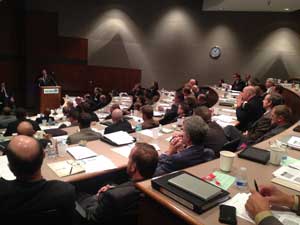 Lawrence, Kan. (Nov. 3, 2015) – More than 100 members from 90 chapters visited GCSAA headquarters last week to cover topics ranging from a final look at the revised members standards proposal, to a chance to hear from candidates nominated for the 2016 board of directors. In addition, delegates participated in constructive dialogue on association issues such as committee structure and marketing initiatives for the association’s 17,500 members.
Lawrence, Kan. (Nov. 3, 2015) – More than 100 members from 90 chapters visited GCSAA headquarters last week to cover topics ranging from a final look at the revised members standards proposal, to a chance to hear from candidates nominated for the 2016 board of directors. In addition, delegates participated in constructive dialogue on association issues such as committee structure and marketing initiatives for the association’s 17,500 members.
For some of the new attendees, it was a chance to learn more about their association.
“I now have a new appreciation for how the association is run and the true value that we receive by simply getting involved,” said GCSA of New England representative Greg Cormier, a certified golf course superintendent (CGCS) and director of golf course operations at Nashawtuc Country Club in Concord, Mass.
Jake Snyman, golf course superintendent at the Palmer Lakeside course at Barton Creek in Austin, Texas, was equally impressed: “I got more out of this than anything I have done in the last 12 years I have been a member,” said Snyman, a 40-year-old from South Africa who has been a superintendent at Barton Creek for three years and was in Lawrence representing the Central Texas GCSA.
Russ Dooge, CGCS, thought it was time well spent, too, even though he has been connected to GCSAA leadership as a chapter delegate annually since 1996.
Dooge, a longtime superintendent and now general manager with golf course management oversight at The Dunes at Maui Lani Golf Course, traveled nearly 4,000 miles from Hawaii for the opportunity to spend 48 hours talking with fellow members and GCSAA staff.
“We talked about member standards at my first chapter delegates meeting in 1997,” recalled Dooge, a member of the Hawaii GCSA. “It is important. But what we are doing in advocacy for the profession and the golf industry as a whole is huge. That is something I can’t do, and it helps me stay in business.”
GCSAA President John O’Keefe, CGCS, gave an overview of the member standards proposal that will be presented for membership approval at the 2016 Golf Industry Show in February. That proposal, developed after more than a year of discussions with chapter delegates and other members, will slightly increase the education points needed for Class A renewal as well as modify the requirements for eligibility, which will continue to be based on a combination of formal education, experience and earned education points.
“While there was some discussion about what will qualify for service points in a strong education platform, I am pleased that we have the full backing and direction from our delegates to move forward,” said O’Keefe, director of golf courses management at Preakness Hills Country Club in Wayne, N.J. “Class A member standards are important for defining who we are, both individually and collectively. They frame a member’s professional identity.”
In addition, GCSAA CEO Rhett Evans shared with delegates a brief snapshot of their association’s priority programs, an overview of how the association has been strengthened in recent years, and a preview of plans for the 2016 Golf Industry Show in San Diego. There was also time devoted to a free-flowing Town Hall session.
Please CLICK HERE to Download the “CHAPTER DELEGATES MEETING OUTCOMES” Document
Please CLICK HERE to Download the full agenda of the 2015 Chapter Delegates Meeting
Rover Ant (Brachymyrmex sp.) control at Hualalai Golf Course/Resort, Hawaii
Please CLICK HERE to Download a printable version.
Report prepared by
Zhiqiang Cheng1, Earl Sanders2, and George Nakashima3
Introduction
The rover ant, Brachymyrmex sp. (Figure 1), alate swarms have been a seasonal nuisance at some of Hawaii’s golf courses for the past several years, especially at Hualalai Golf Course / Resort on Big Island. Colonies are mainly formed in soil underneath turfgrass, bases of trees, and in leaf litter, etc. Alate swarms, attracted to objects in bright colors such as white/yellow shirts, throughout the warm summer months drive golfers off the course, as mating flights usually occur from May to August.
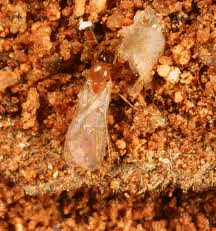
Several entomologists and ant experts have been consulted to review the situation. Major observations and findings prior to this research are briefly summarized as below:
- Brachymyrmex sp. appears to infest all turf areas throughout Hualalai Golf Course / Resort.
- Alate (attracted to light) swarms throughout the warm summer months drive golfers off the course.
- Standard treatments (neonicotinoids, chlorpyrifos, bifenthrin) have not been very effective.
- A bait manufactured on sugar and protein base may be attractive to Brachymyrmex sp.
This research aims to identify effective means to control rover ant, Brachymyrmex sp., at Hualalai Golf Course / Resort, which has been negatively affected by this nuisance turf pest. The golf course superintendent at Hualalai golf course received many complaints from golfers over the years, and is positioned to resolve this situation. In recent observations and communications with several other golf course superintendents, golfers, and home owners, it became apparent that this nuisance ant pest had affected several other golf courses in Hawaii, possibly at Ted Makalena Golf Course, and more. Therefore, this research will not only benefit the superintendent at Hualalai Golf Course / Resort, but will also bring broader benefits to other affected golf courses in Hawaii.
Objectives
The overall objective of this research is to test the efficacies of several newly developed granular ant baits against the rover ant, Brachymyrmex sp., both in the lab and in the field. Specifically,
Objective 1: To determine which ant baits to be included in the field trial, based on lab tests.
Objective 2: To determine the efficacies of selected ant baits against the rover ant, Brachymyrmex sp., in field trial at Hualalai Golf Course / Resort.
Materials and Methods
Several relatively new granular ant baits were tested in this project, including Maxforce Complete (by Bayer), Advance 375A (by BASF), Sieta (by BASF), and Intice (by Rockwell Lab), with and without sugar amendment.
Objective 1: To determine which ant baits to be included in the field trial, based on lab tests.
Seven baiting treatments were tested in the lab to determine which were to be included in the field trial. These were Maxforce Complete (MC), Advance 375A (Ad), Advance 375A + Sugar (AdS), Sieta (Si), Sieta + Sugar (SiS), Intice (In), and Intice + Sugar (InS). The ratio of bait to sugar amendment was 1:1. A control without any bait was included in the lab test. There were 4 replications for each bait and the control. Therefore, 32 petri-dishes were used in the lab test. Five active Brachymyrmex sp. individuals were placed in each petri-dish. Some soil collected together with Brachymyrmex sp. was placed in each petri-dish to mimic the field environment. Attractiveness to baits was observed, and dead ant numbers were counted right after setup, and then at 18 hours, 30 hours, and 48 hours after these ants were exposed to the baits.
Objective 2: To determine the efficacies of selected ant baits against the rover ant, Brachymyrmex sp., in field trial at Hualalai Golf Course / Resort.
Based on lab test results, selected baits were included in the field trial at Hualalai Golf Course / Resort on Big Island, Hawaii. These were MC, AdS, and In. The field plot layout, including the check/control, was as below:
Each plot was 20 ft by 20 ft, and there was a 3-ft buffer area between any 2 adjacent plots to avoid cross-treatment contaminations. Baits were applied at manufacturers’ recommended rates, and irrigation in the field trial area was ceased for 3 days after baits were applied.
Four random spots (1.5×1.5 sq ft, 1 ft deep) were dug in each plot to evaluate Brachymyrmex sp. population density on the scale of 0-3, 0 being no ant at all, 3 being extremely populated with ant eggs, pupae, workers, and alates. Three people evaluated at the same time, and the average of three people’s ratings was considered the final evaluation for each spot. Initial Brachymyrmex sp. population density was evaluated prior to treatments. The same three people did post-treatment ratings at 2 weeks after treatments. Data were subject to appropriate statistical analysis.
Results So Far
As briefly mentioned in Materials and Methods, Maxforce Complete (a.i. 1% Hydramethylnon), Advance 375A + Sugar (a.i. 0.011% Abamectin), and Intice (a.i. 5% boric acid) showed the best overall baiting effects in the lab tests. Maxforce Complete, Advance 375A + Sugar, and Intice resulted in 60-90% mortality at 48 hours. Therefore, these 3 granular baits were included in the field test.
In field trial, however, we did not observe similar results as in lab tests. Figure 2 below shows the ant infestation reduction 2 weeks post treatment. Only Intice shows minor efficacy compared to the untreated control. This result is somewhat unexpected, but not unusual as sometimes lab test results do not match well with field test results due to uncontrollable factors in real world situations.
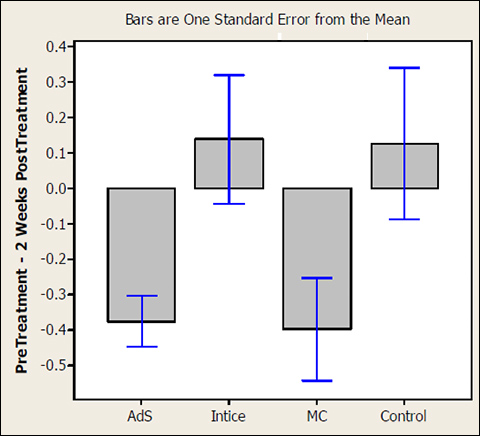
Next Steps
With additional support from GCSAA, we will continue exploring possible means to control Brachymyrmex sp. issues. Some additional granular ant baits will be tested, such as Distance (by NuFram), and modified Intice (with different a.i.), and others. A granular ant bait with fipronil as active ingredient (such as Top Choice by Bayer) will also be tested if permission from Hawaii Dept. of Agriculture is obtained. The research approach will be similar, i.e. conducting lab test first, and then field trial. Repeated applications of selected ant baits may be conducted and field efficacy tested.
In addition, we will explore the possibility of suppressing mealy bugs in the turf area and test if that will result in lower Brachymyrmex sp. population. For this approach, we will include popular insecticides for mealy bug control, such as TriStar, and others.
Acknowledgements
Funding from HGCSA, GCSAA, and Z. Cheng’s Hatch and Smith-Lever projects at CTAHR UH Manoa made this research possible. We also thank staff members at Hualalai Resort for help with field trial, and graduate student in Z. Cheng’s lab for help with lab test.
References
Arnold H. Hara, Cas Vanderwoude, Susan Cabral, and George Nakashima, 2012. Rover Ant, Brachymyrmex obscurior, at Hualalai. DRAFT COPY (05/02/2012). Unpublished data.
Personal communications with Mr. Earl Sanders (Hualalai Resort),Mr. George Nakashima (Crop Production Services), Mr. Art Guzman (Rockwell Labs), and others.
1Zhiqiang Cheng – Assistant Extension Specialist/Professor (Turfgrass and Landscape Pest Management), Dept. of Plant and Environmental Protection Sciences, University of Hawaii at Manoa, Honolulu, Hawaii
2Earl Sanders – Hualalai Golf Course / Resort, Kaupulehu-Kona, Hawaii
3George Nakashima – Crop Production Services, Hilo, Hawaii
Landscape Industry Certified Technician (LICT) 2015 Training

 If you or know someone that is interesting in becoming a Landscape Industry Certified Technician (LICT), classes for training starts in early June! Registration is limited, so please sign up early. Any questions, please contact Madeleine Shaw at 597-0708 or [email protected]
If you or know someone that is interesting in becoming a Landscape Industry Certified Technician (LICT), classes for training starts in early June! Registration is limited, so please sign up early. Any questions, please contact Madeleine Shaw at 597-0708 or [email protected]
Turfgrass education available through the University of Hawaii, Windward Community College on Oahu
A few courses which may be of interest to the professional turf industry; Windward Community College has the only educational program on Oahu dedicated to helping develop turf professionals.
We have a 3 hole par 3 facility to enhance the learning experience.
AG 182 Turfgrass Management meets Wed. 1:30-3:45pm, 1/12-5/13, 3 credits
Identification, maintenance, and planting of turf grass for home, Park, and golf course areas. Discusses irrigation, fertilization, species, and pest control.
AG 40 Turfgrass Equipment meets TH 5-7:45pm 1/13-2/11 1 credit
Teaches the operation and maintenance of equipment used in turf grass operations.
AG 36 Pesticide Safety meets T 5-7:45pm, 2/14-3/18, 1 credit
Pesticide application, formulation, toxicity, transportation, storage, disposal, and rules and regulations governing their use.
This course is worth 17 DOA recertification credits
AG 235 Irrigation Principles and Design meets W 5-7:45pm 1/12-5/13 3 credits
Fundamentals of irrigation principles, plant, soil, water relationships,
soil moisture sensing devices, delivery systems, set up of drip,
sprinkler. Use of chemigation
Registration is now open. Here is a link to the on line application:
http://www.wcc.hawaii.edu/Academics/Agriculture_Technology_CC/index.php
The cost is roughly $100 per credit.
Any questions call me at 236-9265 or email [email protected]

